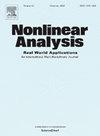Large-time behavior of solutions to outflow problem of full compressible Navier–Stokes–Korteweg equations
IF 1.8
3区 数学
Q1 MATHEMATICS, APPLIED
引用次数: 0
Abstract
In this article, we investigate the large-time behavior of the solution to outflow problem for full compressible Navier–Stokes–Korteweg equations in the one-dimensional half space. The full compressible Navier–Stokes–Korteweg equations model compressible fluids with viscosity, heat-conductivity and internal capillarity, and include the Korteweg stress effects into the dissipative structure of the hyperbolic–parabolic system and turn out to be more complicated than that in the simpler full compressible Navier–Stokes equations. Under some suitable assumptions of the far fields and the boundary values of the density, the velocity and the absolute temperature, the asymptotic stability of the boundary layer, the 3-rarefaction wave, and the superposition of the boundary layer and the 3-rarefaction wave are shown provided that the initial perturbation and the strength of the nonlinear wave are small. The proof is mainly based on -energy method, some time-decay estimates of the smoothed rarefaction wave and the space-decay estimates of the boundary layer. This can be viewed as the first result about the stability of basic wave patterns for the outflow problem of the full compressible Navier–Stokes–Korteweg equations.
全可压缩 Navier-Stokes-Korteweg 方程流出问题解的大时间行为
本文研究了一维半空间中全可压缩 Navier-Stokes-Korteweg 方程流出问题解的大时间行为。全可压缩 Navier-Stokes-Korteweg 方程模拟了具有粘性、导热性和内毛细管性的可压缩流体,并在双曲-抛物线系统的耗散结构中包含了 Korteweg 应力效应,因此比简单的全可压缩 Navier-Stokes 方程更为复杂。在远场以及密度、速度和绝对温度的边界值的一些适当假设下,只要初始扰动和非线性波的强度很小,就能证明边界层、3-反褶波以及边界层和 3-反褶波叠加的渐近稳定性。证明主要基于 L2 能量法、平滑稀释波的一些时间衰减估计和边界层的空间衰减估计。这可以看作是关于全可压缩 Navier-Stokes-Korteweg 方程流出问题基本波型稳定性的第一个结果。
本文章由计算机程序翻译,如有差异,请以英文原文为准。
求助全文
约1分钟内获得全文
求助全文
来源期刊
CiteScore
3.80
自引率
5.00%
发文量
176
审稿时长
59 days
期刊介绍:
Nonlinear Analysis: Real World Applications welcomes all research articles of the highest quality with special emphasis on applying techniques of nonlinear analysis to model and to treat nonlinear phenomena with which nature confronts us. Coverage of applications includes any branch of science and technology such as solid and fluid mechanics, material science, mathematical biology and chemistry, control theory, and inverse problems.
The aim of Nonlinear Analysis: Real World Applications is to publish articles which are predominantly devoted to employing methods and techniques from analysis, including partial differential equations, functional analysis, dynamical systems and evolution equations, calculus of variations, and bifurcations theory.

 求助内容:
求助内容: 应助结果提醒方式:
应助结果提醒方式:


